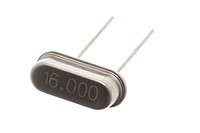 A miniature 16 MHz quartz crystal enclosed in a hermetically sealed HC-49/S package, used as the resonator in a crystal oscillator. | |
| Type | Electromechanical |
|---|---|
| Working principle | Piezoelectricity, Resonance |
| Invented | Alexander M. Nicholson, Walter Guyton Cady |
| First production | 1918 |
| Electronic symbol | |
 | |
A crystal oscillator is an electronic oscillator circuit that uses a piezoelectric crystal as a frequency-selective element.[1][2][3] The oscillator frequency is often used to keep track of time, as in quartz wristwatches, to provide a stable clock signal for digital integrated circuits, and to stabilize frequencies for radio transmitters and receivers. The most common type of piezoelectric resonator used is a quartz crystal, so oscillator circuits incorporating them became known as crystal oscillators.[1] However, other piezoelectric materials including polycrystalline ceramics are used in similar circuits.
A crystal oscillator relies on the slight change in shape of a quartz crystal under an electric field, a property known as inverse piezoelectricity. A voltage applied to the electrodes on the crystal causes it to change shape; when the voltage is removed, the crystal generates a small voltage as it elastically returns to its original shape. The quartz oscillates at a stable resonant frequency, behaving like an RLC circuit, but with a much higher Q factor (less energy loss on each cycle of oscillation). Once a quartz crystal is adjusted to a particular frequency (which is affected by the mass of electrodes attached to the crystal, the orientation of the crystal, temperature and other factors), it maintains that frequency with high stability.[4]
Quartz crystals are manufactured for frequencies from a few tens of kilohertz to hundreds of megahertz. As of 2003, around two billion crystals were manufactured annually.[5] Most are used for consumer devices such as wristwatches, clocks, radios, computers, and cellphones. However, in applications where small size and weight is needed crystals can be replaced by thin-film bulk acoustic resonators, specifically if ultra-high frequency (more than roughly 1.5 GHz) resonance is needed. Quartz crystals are also found inside test and measurement equipment, such as counters, signal generators, and oscilloscopes.
- ^ a b Graf, Rudolf F. (1999). Modern Dictionary of Electronics, 7th Ed. US: Newnes. pp. 162, 163. ISBN 978-0750698665.
- ^ Amos, S. W.; Roger Amos (2002). Newnes Dictionary of Electronics, 4th Ed. US: Newnes. p. 76. ISBN 978-0750656429.
- ^ Laplante, Phillip A. (1999). Comprehensive Dictionary of Electrical Engineering. US: Springer. ISBN 978-3540648352.
- ^ Paul Horowitz, Winfield Hill, The Art of Electronics Second Edition, Cambridge University Press, 1989, ISBN 0-521-37095-7, pg. 300 ff
- ^ Lombardi, Michael (2003). Encyclopedia of Physical Science and Technology (3rd ed.).